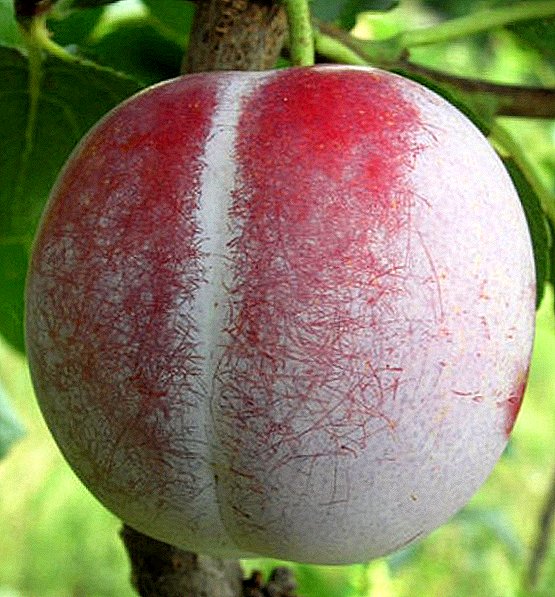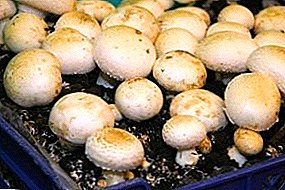 Lilac - very beautiful shrub, which is quite often found in the city and on sites. Unfortunately, like many other plants, it is attacked by pests and various diseases. Consider what diseases and pests affect the shrub and how to deal with them.
Lilac - very beautiful shrub, which is quite often found in the city and on sites. Unfortunately, like many other plants, it is attacked by pests and various diseases. Consider what diseases and pests affect the shrub and how to deal with them.
How to deal with diseases
There are several groups of diseases. Consider them in more detail. 
Viral
Unfortunately, viral pathogens can cause the following ailments:
- ring mottling;
- ring blotch;
- mottling;
- chlorotic leaf spot.
Important! Viral diseases in 99% of cases can not be eliminated, so it is imperative that you follow the preventive recommendations for the protection of lilacs.The virus is transmitted through the soil, seeds, pollen and insects. Symptoms can be different and depend on the type of pathogen, ecology and the state of the plant.
 Common ones include:
Common ones include:- appearance on foliage and flowers of a mosaic color;
- leaf whitening;
- the appearance of a ring-shaped pattern;
- bend leaves up.
Familiarize yourself with the beneficial and harmful properties of lilac.
Fungal
Depending on the variety of fungi, on the foliage of lilac specks may occur, having different sizes, shapes and colors. The most common ailments include:
- askohitoz;
- anthracnose;
- Alternaria;
- septoriosis;
- chalcosporosis.
 In addition to the above, there are the following fungal diseases:
In addition to the above, there are the following fungal diseases:- perforated spotting - characterized by the appearance of specks on the foliage and rotting inflorescences. At first, the specks have a brown-yellow color, gradually becoming completely brown, then brown;
- powdery mildew - affects a plant of any age, characterized by the presence of abundant mealy plaque, having a gray-white color.
Did you know? In England, there was a custom according to which a girl could hand a bouquet of lilacs to the groom on matchmaking - this indicated her refusal.To increase the resistance to such ailments, it is necessary to feed with phosphorus and potassium, apply mineral fertilizers without excess nitrogen. In addition, it is necessary to spray the plants with iron or copper sulphate, Bordeaux liquid.
Learn how to plant a lilac, what to do if it does not bloom, how to propagate it, and how to preserve the cut lilac.This will protect the shrub from spotting. If the infection with powdery mildew has already happened, you should sprinkle the foliage with soda ash and soap or colloidal sulfur. In order to avoid addiction, it is necessary to alternate drugs.
Bacterial
The most common bacterial illnesses include:
- withering - the causative agent is the fungus Verticillium albo-atrum. In the presence of a disease, the plant begins to fade, the foliage falls prematurely, it twists, turns brown and dries. In some cases, the leaves turn yellow near the veins. Gradually, the dying off and drying up of the bushes;
- bacterial rot - affects shoots, foliage, flowers and buds. The disease can be determined by the presence of small wet spots on the rhizome, rapidly increasing in size and acquiring a black color.
 If you notice that the first signs of the disease have appeared, it is necessary to trim the affected parts, while grabbing 10 cm of healthy tissue should be performed.
If you notice that the first signs of the disease have appeared, it is necessary to trim the affected parts, while grabbing 10 cm of healthy tissue should be performed.It will be interesting to know how to cure rust and powdery mildew.
Mycoplasma
The most common disease of this group is panicking. It is characterized by the appearance of the so-called "witch brooms." The reason for their formation is that the shoots placed on the side begin to grow actively, while the development of internodes does not occur. As a result, the branches take the form of small bushes, there is a decrease in the size of the foliage, and the whole plant becomes dwarf, gradually dying.  The defeat of mycoplasmas leads to the fact that there is a development:
The defeat of mycoplasmas leads to the fact that there is a development:
- rosette;
- jaundice;
- chlorosis;
- small leaves;
- abnormal branching;
- premature blooming of the kidneys;
- wilting.
How to deal with pests
Consider which pests attack lilac bushes and how to deal with them.
Acacia spatula
This pest is the enemy of lilac and many forest, ornamental, fruit trees and shrubs. Its habitat is thin twigs, shoots and leaves. Often you can observe small piles of white powder - this is how a cluster of eggs looks like. In winter, the larvae are located at the bottom of the branches, on the trunk, they are firmly attached to the bark.
Plant common lilac, Hungarian, Persian, and Red Moscow.With the arrival of spring, even before the buds bloom, but when the air temperature rises to + 6-7 ° C, they begin their movement in the upper parts of the crown and are fixed on the lower parts of the branches, from which they suck juice. In a large number of insects begin to appear in late spring - early summer.

Important! A lack of potassium in the soil can lead to the development of necrosis, the appearance of spots on foliage and root rot.The emergence of a false shield contributes to the drying of the shoots and twigs, the deterioration of flowering, the reduction of decorative effect and frost resistance. If there are false shields on the shrub for several years, over time the shrubs dry out completely. To protect the plant from lozhnozhitovki, it is worth time to cut dry and infected branches, to carry out the thinning of the crown and the removal of sprouts near the roots. It is recommended to remove dead bark, moss and lichen from old branches and trunks.
Apple tree worm
It is one of the most dangerous pests of shrubs, also affects ornamental, forest and fruit trees. Habitat are branches, shoots, trunks, at least - leaves. Harm is inflicted by females and larvae that live under a scape that has an oblong, comma-like appearance and has a brown-brown color. Its size is about 4 mm.  Egg laying occurs in August and September, they spend the winter under a shield located on the bark and branches. Larvae deposition occurs in May. Due to the exhaustion of the juice with the shield, the branches begin to dry out, and the young plant dies quickly. If the plant is heavily damaged, observe the premature fall of the leaves. Prevention measures are the same as for pseudo shield.
Egg laying occurs in August and September, they spend the winter under a shield located on the bark and branches. Larvae deposition occurs in May. Due to the exhaustion of the juice with the shield, the branches begin to dry out, and the young plant dies quickly. If the plant is heavily damaged, observe the premature fall of the leaves. Prevention measures are the same as for pseudo shield.
Lilac motley moth
In addition to the lilac, the insect harms the ash. It is represented by a yellowish-brown butterfly, whose length is approximately 13-14 mm. On the porches there is a colorful pattern. Butterflies are harmful from May to September. They begin to appear in the period of active flowering. In early May, caterpillars perform foliar mining. At first, the mines have a light color, after which they turn brown and are located almost on the whole leaf. During the summer period, the caterpillars twist the foliage down, across the main vein, and accumulate inside a kind of cocoon.  A measure of the fight and prevention is to dig the soil under shrubs 20 cm deep. At the same time, it is necessary to carry out a reservoir turnover, this is necessary to eliminate moth pupae. During the growing season, it is necessary to regularly collect foliage and burn it together with mines, and twisted leaves are also subject to destruction, since the caterpillars live on them.
A measure of the fight and prevention is to dig the soil under shrubs 20 cm deep. At the same time, it is necessary to carry out a reservoir turnover, this is necessary to eliminate moth pupae. During the growing season, it is necessary to regularly collect foliage and burn it together with mines, and twisted leaves are also subject to destruction, since the caterpillars live on them.
Rosa Cicadas
Quite a common pest, attacks of which undergo ornamental plants, lilac, roses. The harm lies in sucking adults and larvae of juice from the lower parts of the foliage, which leads to the appearance on the upper part of a set of white or yellow-white dots. The larvae hardly move. Winter eggs are carried out on the branches near the base of the kidneys. During the growing season in the fight against cyclists, weevils and other pests, it is recommended to carry out the treatment using Fitoverm and Kemifos.
Weevil
This pest is a polyphagous beetle, the harm of which consists in nibbling the foliage with hollows or coves along the edge, thereby giving the leaves a delicate look. Beetles eat leaves early in the morning, in the evening or at night. During the day, they are located under the bark, and their habitat is folded leaves. The development of larvae occurs in the soil or rhizome of the plant. Most often weevils eat leaves located in the middle and lower tiers of lilac, and also eat near-root growth. For the prevention and control of using the same drugs as for the cicadas.
Leaf mites
Among these pests most common lilac and bud mites. The first has a rather small size - up to 0.2 mm. It sucks the juice from the bottom of the foliage, as a result of which it becomes stiff and brown, in some cases, the mites damage the bark of young branches. In early June, pests multiply. During the winter period, adult insects are placed in the bud scales, and when they bloom, they settle on foliage, most often along the veins.
Read also how to deal with rapeseed leaf beetles, rodents, cabbage soup, midges, and spider mites.Another small representative of this group is the kidney tick. It has a very small size - up to 0.5 mm. The insect lives in the kidneys, gradually deforming them. Their swelling occurs, they cease to shine, scales separate from each other. Damaged plants have underdeveloped leaves, short shoots and very close buds. Wintering pest spends in the kidneys.
Did you know? There is only one type of lilac that does not smell - it is Hungarian lilac.
 For the purpose of prophylaxis, it is recommended to prune and burn the affected shoots in the spring, before the time when the pests come out, as well as in the fall after all the foliage has fallen. Lilac bushes, especially during flowering, are a wonderful decoration of any site. In order to preserve their health, it is necessary to carry out preventive treatments and properly care for the plant.
For the purpose of prophylaxis, it is recommended to prune and burn the affected shoots in the spring, before the time when the pests come out, as well as in the fall after all the foliage has fallen. Lilac bushes, especially during flowering, are a wonderful decoration of any site. In order to preserve their health, it is necessary to carry out preventive treatments and properly care for the plant.











